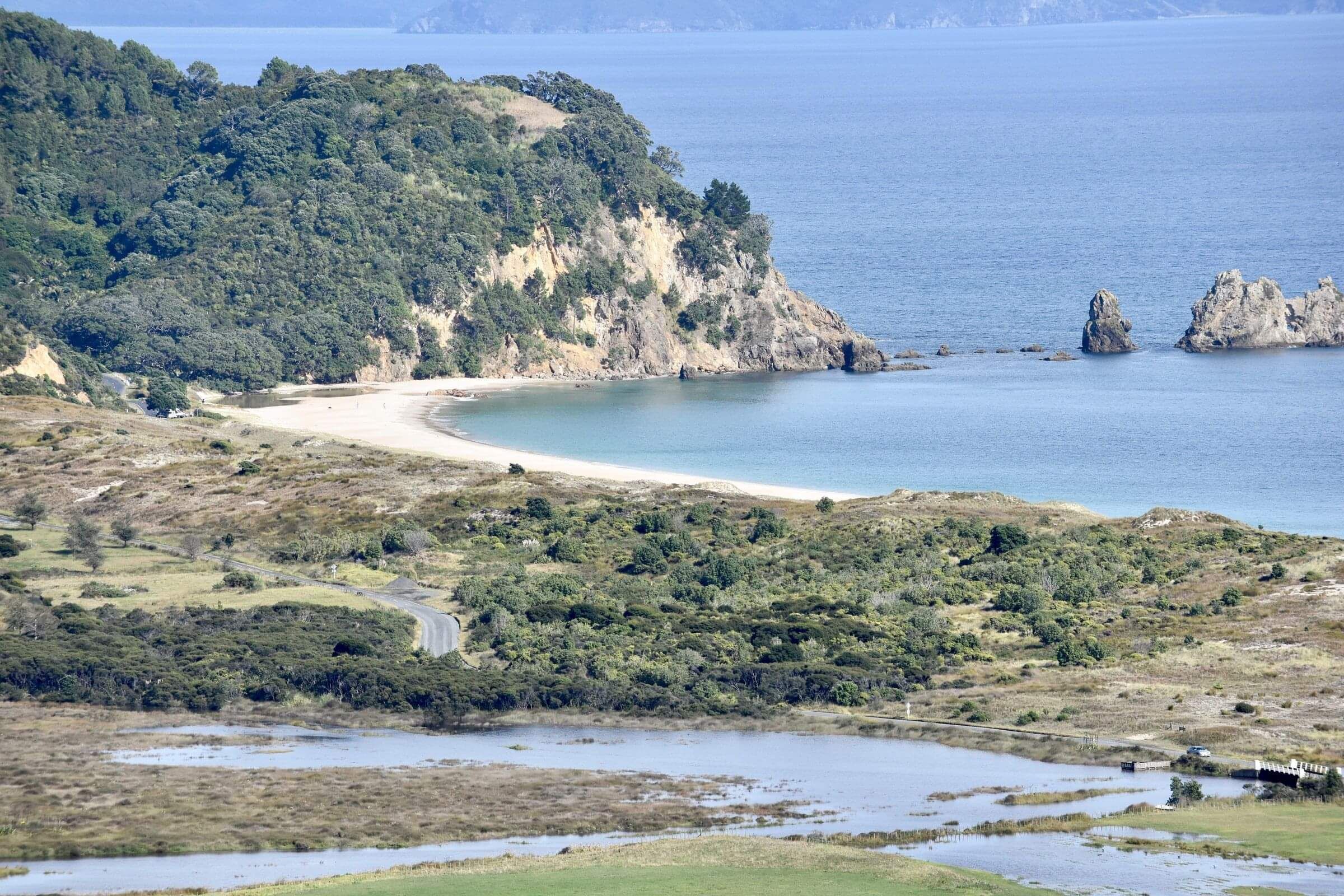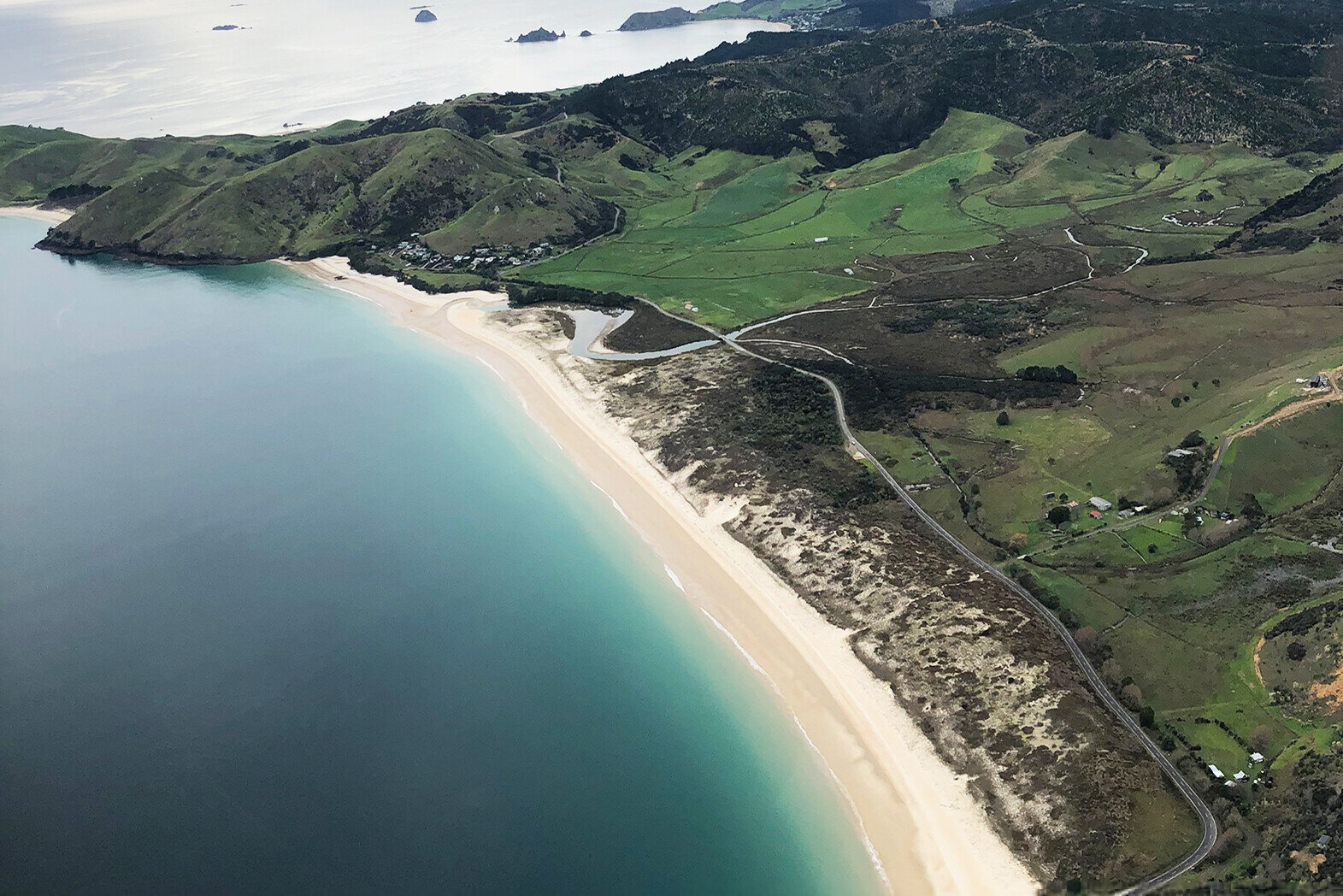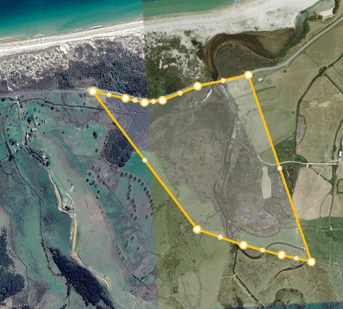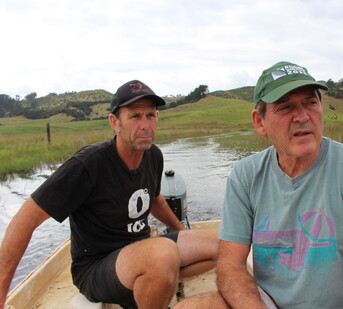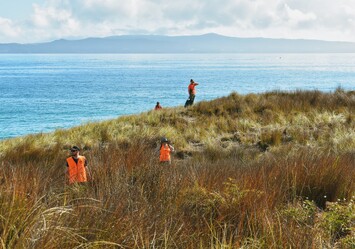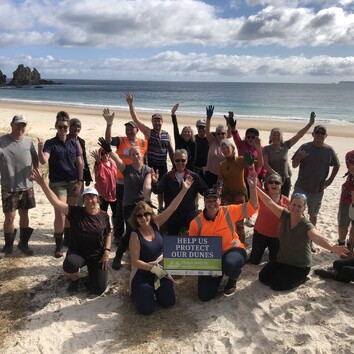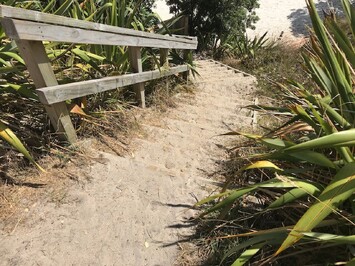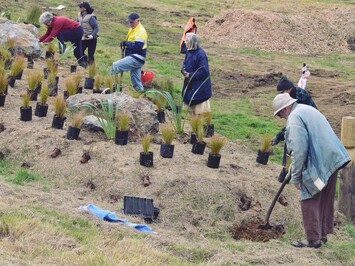Otama Wetland
The Otama Wetland is approximately 25ha in area and is ranked as 376 in the top 500 of the Department of Conservation (DOC)’s national prioritisation system for ecosystem and species.
The wetland’s catchment area includes native forest, and pine forestry in the background hills, and it borders adjacent farm land, a nationally significant regenerating sand dune system, and feeds into a lagoon area which flows onto the foreshore. It is filled by tidal movement when open to the ocean.
The connectivity of this ecosystem and the health of its biodiversity corridor is an important value for the Otama Reserves Group. It is important to recognise that there is a urupā on the perimeter of the wetland/dune border.
The Otama Wetland is home to many significant nationally threatened native plant and bird species and marine life, as well as non- indigenous weed and pest species:
Plants
Arrow Grass, Glasswort, Mangrove, Native Musk, Oioi, Remuremu, Saltmarsh Ribbonwood, Sea Primrose, Sea Rush, Seagrass, Raupo, Slender Clubrush, Manuka, Pohuehue, Blue-Green Sedge.
Birds
NZ Dotteral, North Island Fernbird, Australasian Bittern (Matuku), Banded Rail, Pied Shag, Little Shag, Black Shag, Kingfisher, Oyster Catcher, Blue Penguin, Kiwi, Paradise Duck, Mallard Duck, Pukeko, White-Faced Heron.
Marine Life
Breeding ground for many fish and eel species including Inanga Whitebait.
Pests
feral cats, ferrets, hedgehogs, rats, stoats, possums, rabbits.
Weeds
Saltwater Paspalum, Marram Grass, Japanese Honeysuckle, Ice plant, Woolly Nightshade, Blackberry, Pampas, Convolvulus, Gorse, some pasture grass species.
The Otama Reserves Group currently undertakes pest and weed control in the wetland and is two years into a riparian planting program on five hectares that has recently been fenced off from adjoining farmland.
The quality of the water and land practices directly relate to the health of the wetland; in particular farming practices, siltation from forestry, and draining of the wetland during inundation.
This wetland has been classified as degraded and it is our aim to restore it and bring it back to a healthy functioning wetland, and then engage the community with a bird hide and walkways throughout the wetland.
“We identified very early on that to achieve our goals and aspirations, we would require a comprehensive restoration plan for the reserve – one recognised by local government agencies, iwi, landowners and the community. The restoration plan will give the group a guideline on timeframes for a staged restoration approach over the next decade and how the goals can be achieved.”
Otama Sand Dune Recreation Reserve
The Otama Sand Dune Recreation Reserve is a naturally regenerating sand dune system, environmentally significant in NZ.
The reserve covers approximately 4.8 hectares, extending along most of the 2.5 km length of Otama Beach, and is 250-350 metres wide, forming a protective ridge of sand reserve for the beach.
Maintaining an adequate width of well-vegetated dunes provides a natural buffer that absorbs the impact of coastal erosion during storms and allows the beach and dunes to repair themselves naturally.
For further information on the importance of dune systems in New Zealand see 'Fragile Guide to Waikato Dunes'.
The frontal dunes of this reserve are home to many native sand binding plants such as Spinifex and Pingao. Native ground covers such as Muehlenbeckia (Pohuehue), Sand Caprosma (Coprosma Acerosa), the less commonly found Sand Daphne (Pimelea villosa), as well as native dune rush Knobby Club Rush (Ficinia nodosa), Flax (Phormium Tenax) (Phormium cookianum) and Toetoe (Austroderia) are found on dunes graduating to the landward side.
A wide variety of native shrubs and trees are found in rear dune areas such as Manuka,(Leptospermum Scoparium), Kanuka, (Kunzea Robusta), Taupata (Coprosma Repens), Coastal Five-Finger (Pseudopanax Lessonii), Karo (Pittosporum Crassifolium), Kawakawa (Macropiper Excelsum), Ngaio (Myoporum Laetum), Ake Ake (Dodonea Viscosa) and Pohutukawa (Metrosideras Excelsus), which were probably in the original dune vegetation sequence.
The Otama Dune reserve contains 12 midden sites and connects to the urupā in the wetland. Respecting all of this area and its historical and spiritual significance to the Ngati Hei is a key value to the Otama Reserves Group.
In its more recent history local residents have protected the dunes from threats such as sand mining and coastal development, with DOC purchasing back a privately owned block of land in the sand dunes.
Controlling Weeds and Pests
The Otama Reserve Group is working with DOC, Waikato Regional Council (WRC) and the Thames-Coromandel District Council (TCDC) to keep these dunes free of plant and animal pests, so that they can have the best opportunity to naturally regenerate and provide a safer environment for native birds such as the NZ Dotterel, Oyster Catcher and Blue Penguin that nest in the foredune areas.
Protecting the dunes from introduced exotic plant species which compete with our native sand binders and other native dune species is a key objective in looking after the sand dune reserve. The ORG participates in DOC weeding days when volunteers form a grid across the dunes and target the removal of weed species such as Lupin and Ice Plant (Carpobrotus Edulis).
Our group also targets specific weed species in the dunes such as Pampas (Cordateria Selloana), Gorse (Ulex Eurpoaeus), Blackberry (Rubus Fructicosus) and Woolly Nightshade (Solanum Mauritianum) as part of our weed control programme with Remnant Restoration across all the reserves.
We maintain an extensive trapping line across the dunes to target animal pests such as cats, ferrets, hedgehogs, rats, stoats and possums. Rabbits and wild pigs are also prevalent in the dunes and also pose a threat to dune regeneration.
These combined activities help protect the sand dune system and assist in the natural regeneration of the native vegetation and ongoing maintenance of the natural sand barrier and builds dune resilience.
TCDC and Coastcare - Waikato are undertaking a coastal restoration project on the TCDC Road Reserve and coastal area at the western end of Otama Beach, which borders the Otama Sand Dune Reserve. This project is managed by the TCDC and Coastcare Waikato Coastal Restoration Coordinator, and is part of a shoreline management pan for the Thames Coromandel coastline to protect against coastal erosion.
A community Coastcare Group has also been formed to assist with restorative planting of foredune and backdune plant species which will enhance this public area. The Otama Reserves Group supports this project by assisting with the planting activities.
Otama Beach Recreational Reserve
The Otama Beach Recreational Reserve (Village Reserve) is located at the north-eastern end of Otama Beach.
This reserve covers an area of 13.8 hectares of public recreational land that provides sweeping views of Otama Beach, the wetland, lagoon and sand dune reserves all the way to Motuhua Point, the site of a historic headland pa of the Ngati Hei.
The land also provides sweeping views of the eastern coastline of the Coromandel ranges, the Great Mercury Islands, Little Barrier and Great Barrier Islands out to the east, and if you are lucky, you will occasionally sight dolphins and orca as well as our resident shark, a small blue whaler affectionately named Bruce by local residents.
The cliff area is fringed with magnificent ancient Pohutukawa trees and is suffering from coastal erosion. The reserve provides beach access to Otama Beach and the lagoon area, as well as parking for day vehicles and occasional freedom campers. It also provides a pleasant area for residents to walk their dogs and a Pa Harekeke that was established by the Otama Reserves Group for a local weavers group.
This reserve is home to 2 archaeological pa sites of the Ngati Hei – a village pa and trading post which have connectivity to other significant historical sites within the Otama reserves. A key objective of the Otama Reserves Group and DOC is to acknowledge and protect these historical sites and to educate the public of their significance.
The Otama Reserve Group is passionate about maintaining and enhancing the pristine natural environment of Otama and restoring its native flora and fauna while facing extra environmental pressure from increased tourism and day visitors to Otama. Our pest and weed control and restoration planting activities across all the Otama Reserves impact this recreational reserve and connectivity between the reserves is a key value for the ORG.
Protecting the ancient Pohutukawas and the eroding cliff face whilst providing safe beach access and adequate parking are some of the issues we face.
We have been working with DOC and TCDC to create a Landscape Management Plan to address the key issues facing this recreational space (see What We Do for more information).
Black Jack Scenic Reserve
The Black Jack Scenic Reserve is located at the north-western corner of Otama Beach near Motuhua Point.
This 90 hectare area is included in the settlement of local iwi Ngati Hei and contains a significant headland pa site.
Our initial plans to preserve this area include setting up a trap line and undertaking weed control of the Pampas.
